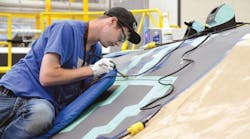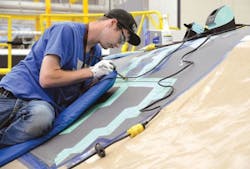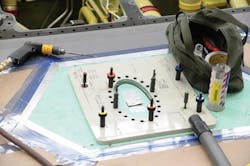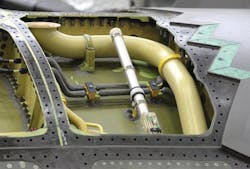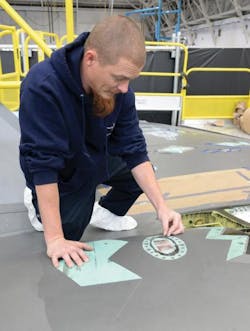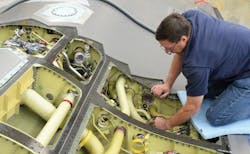It’s been just three months since the U.S. Air Force declared the long-awaited F-35A ready for combat. But already the joint government-Lockheed Martin operation that manages the world’s largest fighter program has overcome a major hurdle, returning most of the operational fleet to the skies just weeks after grounding 15 aircraft due to debris discovered inside the wing fuel tanks.
The rapid turnaround of a complex maintenance challenge reflects the Joint Strike Fighter’s (JSF) successful transition from brand-new development program to mature—if not yet fully-fledged—operational fleet. Where previously a minor modification could throw operators off schedule for months, the airmen and contractors tasked with maintaining the fleet identified and fixed the latest problem within a few weeks.
Although the Joint Program Office initially estimated the aircraft would return to service by the end of the year, almost all the F-35s of the “Rude Rams” 34th Fighter Sqdn. here at Hill AFB, Utah, are now back in the sky—more than a month ahead of schedule. All 10 aircraft have now received the insulation fix, and eight were expected to be flying by Nov. 11. Airmen are still conducting operational checks on one of the remaining jets, while the other is in depot maintenance for a previously planned modification.
A Maintenance Success Story
- Engineering teams designed a minimally invasive modification that takes just three weeks to complete
- F-35s of the 34th Fighter Sqdn. are returning to the skies much faster than anticipated
- The accelerated schedule speaks to Lockheed Martin’s maturing manufacturing processes and maintainers’ growing experience with the aircraft
- The “Rude Rams” should be fully back on schedule by December
“The recovery time has been pretty incredible,” says Lt. Col. George Watkins, the squadron’s commander. “When I first heard of the issue, I really thought it would be 6-12 months before we’d get some of the jets fixed. But it’s looking like they are all going be back to us by the end of Thanksgiving [Nov. 24]—or even before.”
Early assessments indicated the impacted fighters—including 10 of 15 aircraft in the Air Force’s first operational F-35 squadron, as well as 42 in-production models—would be down for three months due to crumbling insulation that technicians feared could clog the fuel tanks running through the wings, according to Senior Master Sgt. Robert Soto, lead production superintendent, 34th Air Maintenance Unit. But Lockheed and the government have defied the odds, rapidly moving to identify the root cause of the problem—a supplier mistake, not a technical development issue—design a fix for the affected aircraft, and implement a solution.
The repair work was not nearly as extensive as many had anticipated, because government-industry engineering teams designed a minimally invasive modification that takes just three weeks to complete, according to the airmen. Far from tearing apart the wings to access and remove the loose insulation, engineers designed 3-D-printed “templates” that a field-team of contract maintainers used to cut small holes—up to seven on each wing—that enabled access to specific points in the aircraft without massive cutting, explains Greg Hoffman, director of Ogden Air Logistics Complex’ 570th Aircraft Maintenance Sqdn.
Once inside the wing, workers used "special tooling" to strip the faulty coating from the Polyalphaolefin (PAO) coolant tubes installed in the fuel tanks, and find and remove any loose insulation. In a recent interview with Aviation Week, Gen. Ellen Pawlikowski, chief of Air Force Materiel Command, compared the work to laparoscopic surgery.
Once they had ensured every last inch of insulation was gone, the maintainers then installed screens inside the wings as a backup measure to prevent any foreign object from clogging the fuel siphon tubes.
After the wing repair, the team restored each F-35’s skin and low-observable coating. Airmen then completed operational checks on the aircraft before returning it to service.
The team’s ability to repair all 10 aircraft in just a few weeks came down to the around-the-clock work of the engineers and maintenance team, as well as cooperation between the government and Lockheed Martin, according to the airmen.
“I will tell you that it was pretty invasive. However, Lockheed Martin and all the folks involved in the program got together, and as invasive as it was they were rapidly able to execute and return the aircraft back to us,” says Capt. Richard Palz, officer in charge with the 34th Aircraft Maintenance Unit.
The accelerated schedule speaks to Lockheed Martin’s maturing manufacturing process. Engineers were able to design a minimally invasive solution because they knew exactly where on the aircraft the repairs would need to occur, says Greg Ulmer, company vice president for the F-35 production business unit. Meanwhile, the team also had the knowledge and experience to be able to insert the modifications into the production line without interrupting normal workflow. If this problem had occurred five years ago, the line would have seen significantly more disruption, he says.
“That’s all because of our understanding relative to the knowledge we’ve gained and the maturity we have in producing the aircraft,” Ulmer says. “Today because our job packages are extremely well-defined, we understand the toolset, we understand the efficiencies and the build rate that we execute to, we can adjust those manufacturing dials to do this work as concurrently and efficiently as we can in addition to our normal production work.”
These Companies Put Fighter Pilots To The Test
Trump NASA Transition Set In Motion
Rockwell Collins Working On Touch Screens, Smarter Pilot Assistance
Altogether, 57 F-35As were affected by the PAO lines issue: 13 operational Air Force aircraft, two operational Norwegian models, and 42 in-production jets for the U.S., Norway, Japan, Italy and Israel. Lockheed has completed the modification and flight acceptance process for three of those in-production jets, and is hard at work on seven more. The company expects to deliver the first Israeli and Japanese jets on schedule in December, Ulmer says. All of the modifications are on track to be completed by the middle of 2017.
Despite progress, every time an unexpected problem crops up fleet readiness levels drop. With 10 aircraft down due to the PAO lines issue the 34th Fighter Sqdn. was left with just five operational aircraft during most of September and October, leading pilots to miss crucial sorties and training opportunities. To minimize the impact, some of Hill’s pilots were sent to Luke, Eglin and Nellis AFBs to use any additional F-35s available, says Watkins. Meanwhile, maintainers at Hill pushed the unaffected jets to provide additional sorties, “hot-pitting” the aircraft to fly as many as three times a day.
But by December, the Rude Rams should be back up to full speed, according to Watkins.
“It hasn’t been too big of a burden, between flying off-station and getting a few less sorties than you normally would. We will manage through the low time now, and then we will get back up into center,” he says.
For now, it is on to the next battle. Both the Air Force and U.S. Marine Corps are investigating two separate incidents: a Sept. 23 tailpipe fire on an F-35A from Luke and an Oct. 27 weapons bay fire on an F-35B based out of Beaufort, South Carolina. The root cause of both is unclear at this time, as is the extent of the damage on the $100 million aircraft.
